Your David vs. Goliath Guide to Black Friday for Owner-Managed Ecommerce Businesses
Breaking the Discount Death Spiral
Every November, the same script plays out across retail: brands slash prices, margins evaporate, and customer expectations reset to expect everything cheaper. It’s a destructive cycle that turns Black Friday from a profit opportunity into a margin-killing necessity. As a small business retailer you sigh with despair because you just cannot match the discounts or the marketing advertising spend of the big guys.
But here’s what the big retailers don’t want you to know: owner-managed ecommerce businesses have a secret weapon. While corporate giants are trapped in boardroom-approved discount strategies, you have the agility, authenticity, and customer relationships to flip the script and win the Black Friday Race.
This isn’t about competing on price, it’s about competing on value, creativity, and genuine customer connection. Some of the most successful Black Friday campaigns in history have done exactly the opposite of what everyone expects.
The rest of this article explores
- Part 1 – Three tried and tested frameworks
- Part 2 – Five new frameworks that build brand value
- Part 3 – The owner manager advantage – how you can win in 2025
- Part 4 – Five campaign concepts you can use
- Part 5 – Metrics and success over the long term
Part 1: Tried & Tested Frameworks (And Why They’re Failing)
Before we break the Black Friday marketing rules, let’s understand them. Here are the 3 frameworks that built Black Friday and why they’re becoming less effective year by year.
1. The Classic Discount Stack
What it looks like:
- Sitewide percentages (15-50% off)
- Tiered discounts (“Spend $100, save $20”)
- BOGO offers (Buy One Get One Free)
- Bundle pricing (Buy these two things together)
Why it works: Simple to execute, easy for customers to understand, creates immediate urgency.
Why it’s failing: Every brand does this now. Your 30% off looks identical to your competitor’s 30% off. The worst part of this is that it trains customers to only buy when things are cheap, and you’re in a race to zero with your margins. This is a particular problem in New Zealand where “everyone loves a special”.
Best for: High-volume, low-margin products where you can afford the hit and need to move inventory.
2. The Urgency Trinity
What it looks like:
- Limited time (“24-hour flash sale”)
- Limited quantity (“Only 50 left in stock”)
- Limited access (“VIP early access for subscribers”)
Why it works: Leverages FOMO (Fear of Missing Out) psychology and scarcity principles that drive immediate action.
Why it’s failing: Customers have become immune to fake scarcity. They know your “limited time” offer will probably be back next week, and your “only 50 left” might not be true.
Best for: Genuinely limited or seasonal products where scarcity is real.
3. The Bundle Strategy
What it looks like:
- Gift sets and curated collections
- “Complete the look” packages
- Cross-category bundles
Why it works: Increases average order value without deep individual product discounts.
Why it’s declining: Customers are more informed and prefer to choose their own combinations. Generic bundling feels lazy.
Best for: Products that naturally complement each other or themed collections. Works well if you know the customer has already purchased one of the products.
Part 2: The New Rules: 5 Frameworks That Actually Build Value
Framework 1: The Anti-Black Friday Revolution
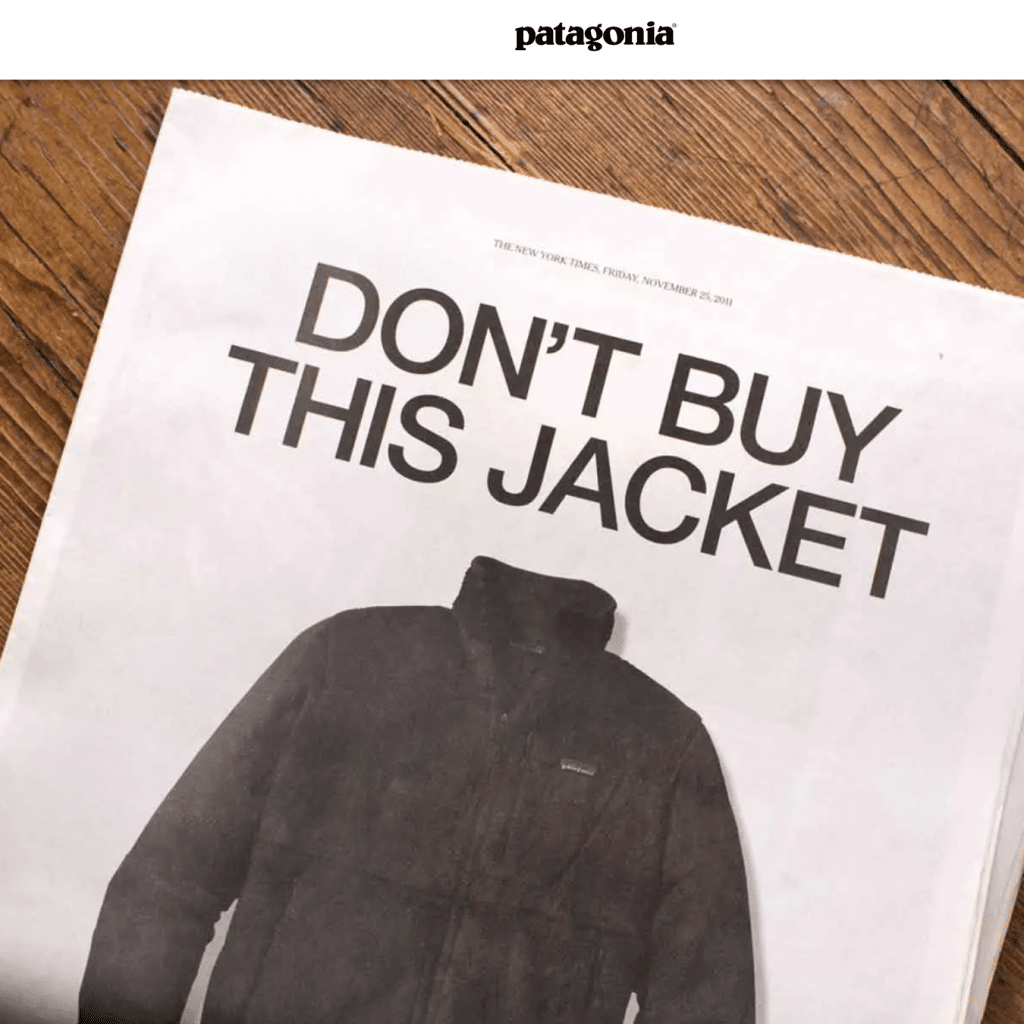
The Strategy: Instead of discounting, take a stand against consumerism and Black Friday culture itself.
Real Example: In 2011, Patagonia published an audacious full-page ad in The New York Times on Black Friday telling viewers not to buy their jacket. With this ad, the company aspired to raise consumer awareness regarding the consequences of over-consumption, especially in the textile industry.
The Result: Instead of hurting sales, the campaign generated massive media coverage, strengthened brand loyalty, and attracted environmentally conscious customers who became lifelong advocates.
Another Iconic Example: Cards Against Humanity made headlines in 2013 for increasing its prices by $5 as part of a Black Friday “anti-sale”. Despite its higher price, the game maintained its best-selling status on Amazon and experienced a minor spike in sales during that period. In other campaigns they’ve also sold “Nothing for $5” (literally nothing) and made $70K, and even sold boxes of actual bull sh*t.
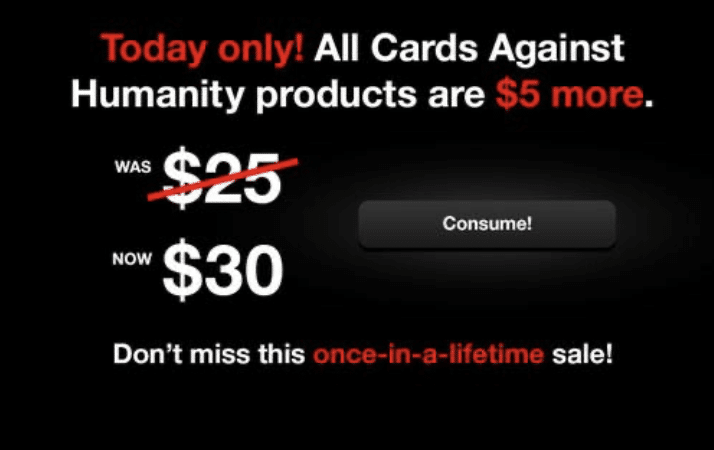
How to execute for your business:
- For sustainable/ethical brands: “We don’t discount quality” campaign with focus on fair wages, sustainable materials, craftsmanship
- For luxury/artisan brands: “Black Friday is for mass production, not masterpieces” – emphasise your craftsmanship story
- For service-based: “We’re closed on Black Friday” why not give your team the day off and make your brand messaging for this day about values? You value your staff.
Perfect for: Brands with strong values, premium positioning, or customers who align with counter-culture movements.
Framework 2: The Value-First Revolution
The Strategy: Instead of reducing prices, add value through exclusive services, bonuses, or experiences.
Real Examples:
- Warby Parker: Free home try-on service becomes “Black Friday: Try 10 spectacles frames at home instead of 5”
- Casper Mattresses: Same mattress price but includes premium bedding set, white-glove setup, and extended trial period
- Local jewellery shop: “Black Friday Concierge” – personal shopping appointments with complimentary wine and snacks
How to execute:
- Premium shipping/service: Express shipping, white-glove delivery, or setup services
- Exclusive access: Behind-the-scenes content, founder calls, early access to new products
- Educational value: Free courses, consultations, or masterclasses with purchase
- Experience add-ons: Virtual styling sessions, personalised consultations, shopping assistance
Perfect for: Service-oriented businesses, premium brands, or companies with expertise to share.
Framework 3: The Community Commerce Model
The Strategy: Make customers active participants in your Black Friday campaign, not just recipients.
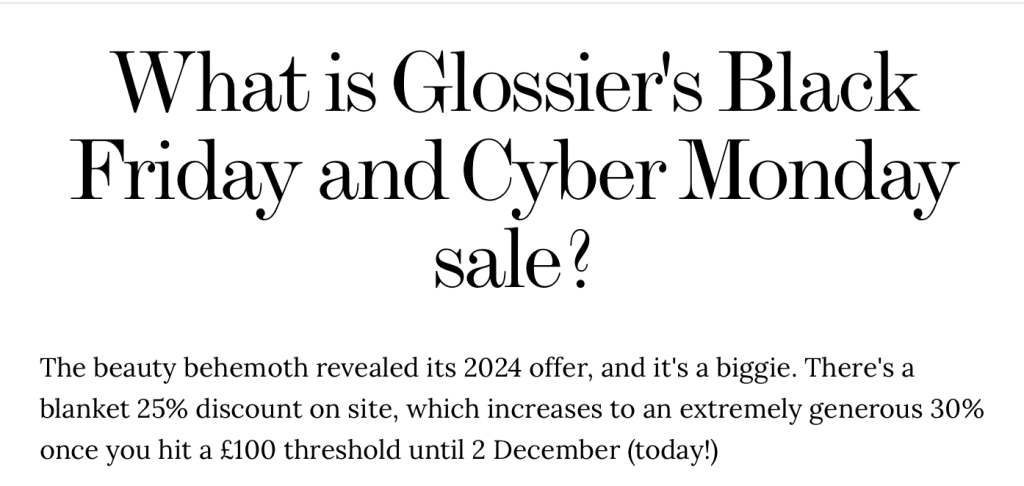
Real Examples:
- Glossier: User-generated content campaigns where customers become models
- Airbnb: Referral multipliers where both parties benefit
- Small coffee roaster: “Tag a friend who needs good coffee” – both get 20% off
How to execute:
- Referral multipliers: Friend saves 20%, you save 20%
- UGC contests: Best product photos/videos win prizes, all participants get discount codes
- Community challenges: “Help us reach 1000 orders and everyone gets a bonus gift”
- Social proof campaigns: Feature real customers, their stories, and offer them ambassador perks
Perfect for: Brands with engaged communities, lifestyle products, or businesses with strong social media presence.
Framework 4: The Experience Economy Approach
The Strategy: Sell experiences and stories, not just products.

Real Examples:
- Allbirds: Virtual factory tours showing sustainable manufacturing
- Ben & Jerry’s: Live ice cream making sessions with founders
- Local bakery: “Black Friday Baking Class” – learn to make signature items
How to execute:
- Live shopping events: Host live product demos with Q&A
- Virtual experiences: Behind-the-scenes tours, meet-the-maker sessions
- Limited collaborations: Partner with local artists, influencers, or complementary brands
- Customisation experiences: Live personalisation, custom packaging, or made-to-order items
Perfect for: Artisan brands, food/beverage companies, or businesses with interesting production processes.
Framework 5: The Micro-Moment Marketing
The Strategy: Hyper-personalised, multi-channel campaigns that meet customers exactly where they are.
The Science: Studies show that using a mix of channels creates more impactful campaigns than relying on single-channel approaches.
Real Examples
- Spotify: “Your Black Friday Wrapped” – personalised playlists with product recommendations
- Nike: App-based campaigns with Augmented Reality try-ons and personalised workout plans
- Local bookstore: Personalised book recommendations via SMS based on previous purchases
How to execute:
- Behaviour-triggered campaigns: Different offers based on browsing history, purchase patterns, or engagement level
- Channel orchestration: Email announcement → SMS reminder → social media FOMO → retargeting ads
- Real-time personalisation: Dynamic website content, personalised product recommendations
- Micro-segmentation: Different campaigns for new customers, VIPs, repeat buyers, at-risk customers
Perfect for: Businesses with good customer data, multiple touchpoints, or diverse customer segments.

Part 3: The Owner-Manager Advantage
Here’s why these strategies work better for owner-managed businesses than corporate giants:
1. Authentic Storytelling
Corporate brands have marketing committees and brand guidelines. You have a real story, real personality, and real relationships with customers. Use them. Customers recognise your authentic voice.
2. Rapid Execution
While big retailers need months of planning and committee approvals, you can pivot in days. Saw a competitor do something boring? Counter with something memorable by next week tomorrow.
3. Personal Connection
You can personally respond to customers, share your own story, and build genuine relationships. Your customers aren’t buying from a faceless corporation, they’re buying from YOU.
4. Creative Freedom
No corporate legal team is going to approve Cards Against Humanity’s bull sh*t campaign. But as an owner-manager, you can take calculated creative risks that generate massive buzz.
5. Values-Driven Marketing
Customers increasingly buy from brands whose values align with theirs. As an owner, your personal values can become powerful differentiators.
Part 4: Implementation Guide – Choose Your Fight
Get in touch with the numero® team and let us go to fight on your behalf next Black Friday.
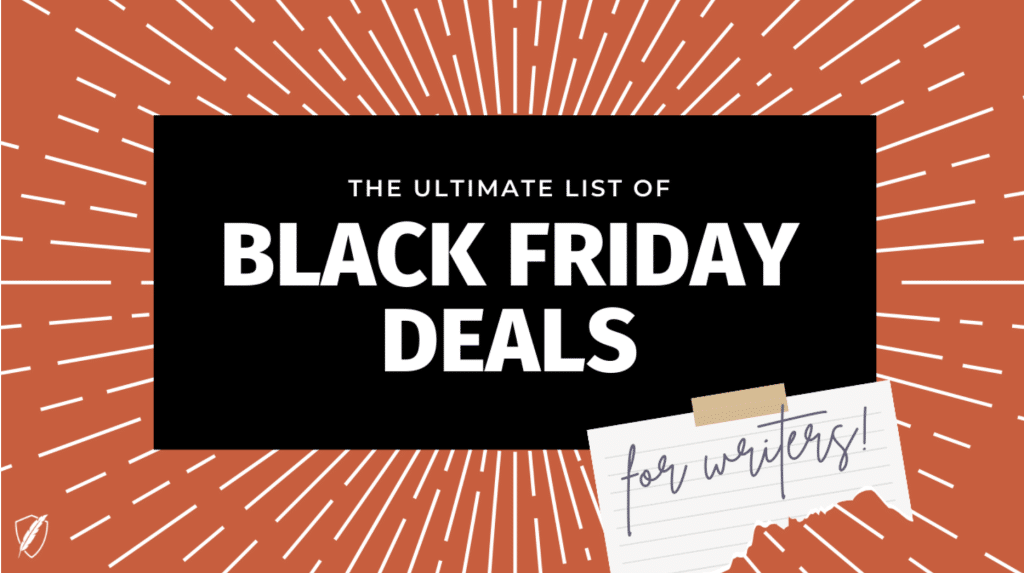
For Premium/Luxury Brands: The Anti-Black Friday Revolution
- Campaign name: “Craftsmanship Doesn’t Go on Sale”
- Key message: Quality over quantity, values over discounts
- Execution: Behind-the-scenes content showing craftsmanship, the founder story about why you don’t discount
- Channels: Email to VIP customers, social media storytelling, PR outreach
For Service-Based Businesses: The Value-First Revolution
- Campaign name: “Black Friday Upgrades”
- Key message: Same investment, premium experience
- Execution: Add consultations, premium support, exclusive access, or extended guarantees
- Channels: Email campaigns, LinkedIn for B2B, Google Ads highlighting value-adds
For Community-Driven Brands: The Community Commerce Model
- Campaign name: “Friends & Family Friday”
- Key message: Better together, shared benefits
- Execution: Referral programs, UGC contests, community challenges
- Channels: Social media, email to advocates, influencer partnerships
For Artisan/Maker Brands: The Experience Economy Approach
- Campaign name: “Behind the Magic”
- Key message: Process over product, story over sale
- Execution: Live demonstrations, virtual workshops, maker stories
- Channels: Instagram Live, YouTube, email storytelling
For Data-Rich Businesses: The Micro-Moment Marketing
- Campaign name: “Your Personal Black Friday”
- Key message: Tailored just for you
- Execution: Personalised recommendations, behaviour-triggered campaigns, dynamic content
- Channels: Email automation, SMS, retargeting ads, app notifications
Part 5: Measuring Success Beyond Revenue
Traditional Black Friday metrics focus on immediate sales, but value-building campaigns require different KPIs:
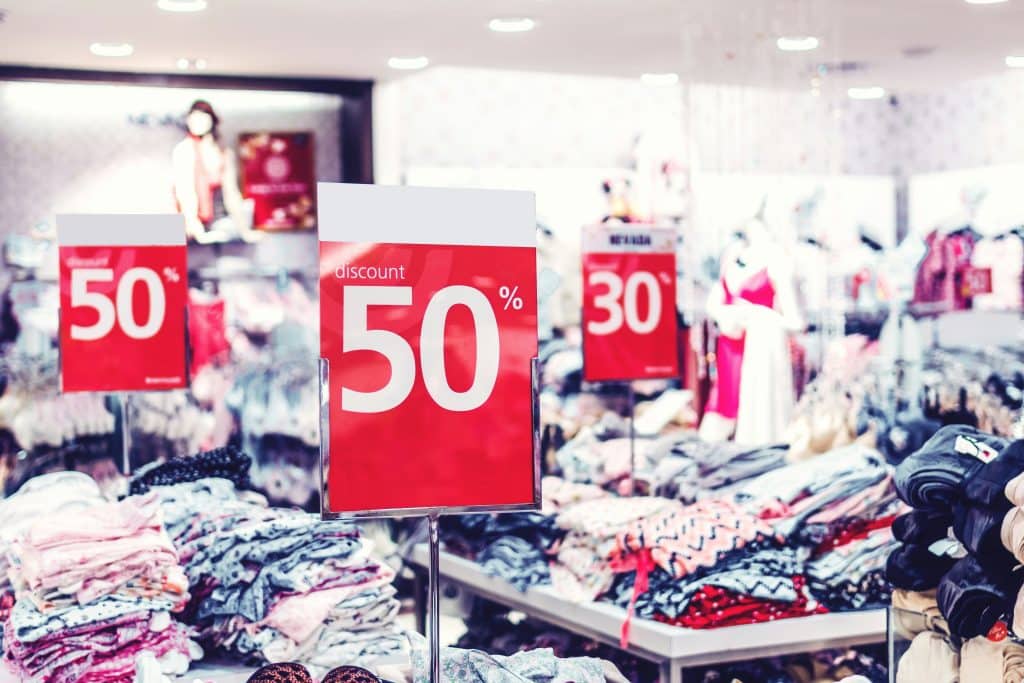
Immediate Metrics:
- Engagement rates (email opens, social media interactions)
- Brand mention sentiment (positive vs. negative coverage)
- New customer acquisition cost
- Email/social subscriber growth (follower count)
Long-term Metrics:
- Customer lifetime value (do these customers stick around?)
- Brand perception studies (pre/post campaign surveys)
- Organic reach and mentions (earned media value)
- Customer retention rates (90-day, 6-month cohorts)
The Ultimate Metric: Customer Love
- Unsolicited testimonials
- User-generated content
- Word-of-mouth referrals
- Repeat purchase behaviour
Conclusion: Your Black Friday Revolution Starts Here
The brands that will thrive in the next decade aren’t the ones with the deepest discounts. They’re the ones that build the strongest relationships. Black Friday gives you a moment when everyone’s paying attention. The question is: what do you want your customers to remember?
While your competitors are trapped in the discount death spiral, you have the opportunity to stand out, build value, and create customers who choose you for reasons that go far beyond price.
The revolution starts with a simple decision: Will you race to zero, or will you build something that lasts?
Your customers are tired of being sold to. They’re ready to be inspired, included, and valued.
The choice is yours.
Ready to plan your value-building Black Friday campaign? Start by identifying which framework aligns best with your brand values and customer base. Remember: the goal isn’t to win Black Friday, it’s to build a business that doesn’t need Black Friday to succeed. Ask numero® to add their expertise to your team.




